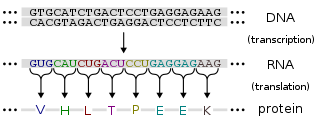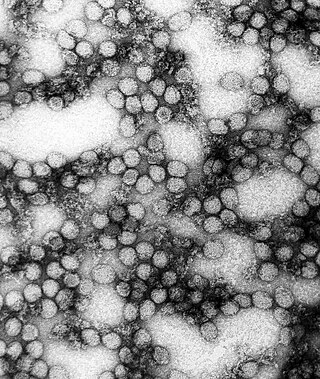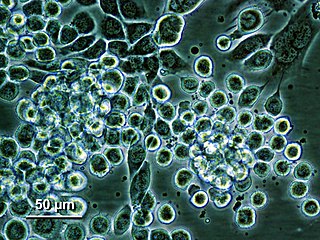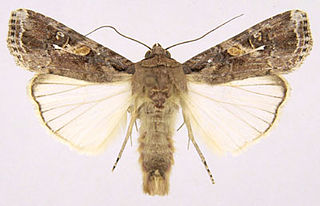
Protein production is the biotechnological process of generating a specific protein. It is typically achieved by the manipulation of gene expression in an organism such that it expresses large amounts of a recombinant gene. This includes the transcription of the recombinant DNA to messenger RNA (mRNA), the translation of mRNA into polypeptide chains, which are ultimately folded into functional proteins and may be targeted to specific subcellular or extracellular locations.

Rhabdoviridae is a family of negative-strand RNA viruses in the order Mononegavirales. Vertebrates, invertebrates, plants, fungi and protozoans serve as natural hosts. Diseases associated with member viruses include rabies encephalitis caused by the rabies virus, and flu-like symptoms in humans caused by vesiculoviruses. The name is derived from Ancient Greek rhabdos, meaning rod, referring to the shape of the viral particles. The family has 40 genera, most assigned to three subfamilies.

Flavivirus, renamed Orthoflavivirus in 2023, is a genus of positive-strand RNA viruses in the family Flaviviridae. The genus includes the West Nile virus, dengue virus, tick-borne encephalitis virus, yellow fever virus, Zika virus and several other viruses which may cause encephalitis, as well as insect-specific flaviviruses (ISFs) such as cell fusing agent virus (CFAV), Palm Creek virus (PCV), and Parramatta River virus (PaRV). While dual-host flaviviruses can infect vertebrates as well as arthropods, insect-specific flaviviruses are restricted to their competent arthropods. The means by which flaviviruses establish persistent infection in their competent vectors and cause disease in humans depends upon several virus-host interactions, including the intricate interplay between flavivirus-encoded immune antagonists and the host antiviral innate immune effector molecules.

Baculoviridae is a family of viruses. Arthropods, among the most studied being Lepidoptera, Hymenoptera and Diptera, serve as natural hosts. Currently, 85 species are placed in this family, assigned to four genera.

Sf21 is a continuous cell line developed from ovaries of the Fall Army worm, Spodoptera frugiperda, a moth species that is an agricultural pest on corn and other grass species. It was originally developed in the United States at the Henry A. Wallace Beltsville Agricultural Research Center. Sf9 is a substrain (clone) of these cells that was isolated from Sf21 by researchers at Texas A&M University.
Snakehead rhabdovirus (SHRV) is a novirhabdovirus that affects warm water wild and pond-cultured fish of various species in Southeast Asia, including snakehead for which it is named.

Ascoviridae is a family of double strand DNA viruses that infect primarily invertebrates, mainly noctuids and spodoptera species; it contains two genera, Ascovirus, which contains three species, and Toursvirus with a single species Diadromus pulchellus toursvirus.

59 kDa 2'-5'-oligoadenylate synthetase-like protein is an enzyme that in humans is encoded by the OASL gene.

Nudiviruses are animal viruses that constitute the family Nudiviridae. Insects and marine crustaceans serve as natural hosts. There are 11 species in this family, assigned to 4 genera. Diseases associated with this family include: death in larvae, chronic disease in adults.

The fall armyworm is a species in the order Lepidoptera and one of the species of the fall armyworm moths distinguished by their larval life stage. The term "armyworm" can refer to several species, often describing the large-scale invasive behavior of the species' larval stage. It is regarded as a pest and can damage and destroy a wide variety of crops, which causes large economic damage. Its scientific name derives from frugiperda, which is Latin for lost fruit, named because of the species' ability to destroy crops. Because of its propensity for destruction, the fall armyworm's habits and possibilities for crop protection have been studied in depth. It is also a notable case for studying sympatric speciation, as it appears to be diverging into two species currently. Another remarkable trait of the larva is that they consistently practice cannibalism, despite its fitness costs.

Iflaviridae is a family of positive sense RNA viruses insect-infecting viruses. Some of the insects commonly infected by iflaviruses include aphids, leafhoppers, flies, bees, ants, silkworms and wasps. The name "Ifla" is derived from the name "Infectious flacherie virus", a member species. There is one genus (Iflavirus) and 16 species in this family.
The use of insect cell lines as production hosts is an emerging technology for the production of bio pharmaceuticals. There are currently more than 100 insect cell lines available for recombinant protein production with lines derived from Bombyx mori, Mamestra brassicae, Spodoptera frugiperda, Trichoplusia ni, and Drosophila melanogaster being of particular interest. Insects cell lines are commonly used in place of prokaryotic ones because post-translational modifications of proteins are possible in insect cells whereas this mechanism is not present in prokaryotic systems. The Sf9 cell line is one of the most commonly used lines in insect cell culture.
The agriculture industry in Puerto Rico constitutes over $800 million or about 0.69% of the island's gross domestic product (GDP) in 2020. Currently the sector accounts for 15% of the food consumed locally. Experts from the University of Puerto Rico argued that these crops could cover approximately 30% of the local demand, particularly that of smaller vegetables such as tomatoes, lettuce, etc. and several kinds of tubers that are currently being imported. The existence of a thriving agricultural economy has been prevented due to a shift in priorities towards industrialization, bureaucratization, mismanagement of terrains, lack of alternative methods and a deficient workforce. Its geographical location within the Caribbean exacerbates these issues, making the scarce existing crops propense to the devastating effects of Atlantic hurricanes.
Viral synapse is a molecularly organized cellular junction that is similar in some aspects to immunological synapses. Many viruses including herpes simplex virus (HSV), human immunodeficiency virus (HIV) and human T-lymphotropic virus (HTLV) have been shown to instigate the formation of these junctions between the infected ("donor") and uninfected ("target") cell to allow cell-to-cell transmission. As viral synapses allow the virus to spread directly from cell to cell, they also provide a means by which the virus can escape neutralising antibody.

The Early 35 kDa protein, or P35 in short, is a baculoviral protein that inhibits apoptosis in the cells infected by the virus. Although baculoviruses infect only invertebrates in nature, ectopic expression of P35 in vertebrate animals and cells also results in inhibition of apoptosis, thus indicating a universal mechanism. P35 has been shown to be a caspase inhibitor with a very wide spectrum of activity both in regard to inhibited caspase types and to species in which the mechanism is conserved.

Agnoprotein is a protein expressed by some members of the polyomavirus family from a gene called the agnogene. Polyomaviruses in which it occurs include two human polyomaviruses associated with disease, BK virus and JC virus, as well as the simian polyomavirus SV40.
Parramatta River virus (PaRV) is an insect virus belonging to Flaviviridae and endemic to Australia. It was discovered in 2015. The virus was identified from the mosquito Aedes vigilax collected from Sydney under the joint research project by scientists at the University of Queensland and the University of Sydney. In experimental infections, the virus is unable to grow in vertebrate cells, but only in Aedes-derived mosquito cell lines. This suggests that the virus does not infect vertebrates. The name is given because it was discovered from Silverwater, a suburb of Sydney on the southern bank of the Parramatta River. The mosquitoes from which the virus was isolated were actually collected in 2007, and had been preserved since then. The study commenced only after the development of the technique of viral detection in mosquitoes in the University of Queensland.
Flock House virus (FHV) is in the Alphanodavirus genus of the Nodaviridae family of viruses. Flock House virus was isolated from a grass grub at the Flock House research station in Bulls, New Zealand. FHV is an extensively studied virus and is considered a model system for the study of other non-enveloped RNA viruses owing to its small size and genetic tractability, particularly to study the role of the transiently exposed hydrophobic gamma peptide and the metastability of the viral capsid. FHV can be engineered in insect cell culture allowing for the tailored production of native or mutant authentic virions or virus-like-particles. FHV is a platform for nanotechnology and nanomedicine, for example, for epitope display and vaccine development. Viral entry into host cells occurs via receptor-mediated endocytosis. Receptor binding initiates a sequence of events during which the virus exploits the host environment in order to deliver the viral cargo in to the host cytosol. Receptor binding prompts the meta-stability of the capsid–proteins, the coordinated rearrangements of which are crucial for subsequent steps in the infection pathway. In addition, the transient exposure of a covalently-independent hydrophobic γ-peptide is responsible for breaching cellular membranes and is thus essential for the viral entry of FHV into host cells.

A cell suspension or suspension culture is a type of cell culture in which single cells or small aggregates of cells are allowed to function and multiply in an agitated growth medium, thus forming a suspension. Suspension culture is one of the two classical types of cell culture, the other being adherent culture. The history of suspension cell culture closely aligns with the history of cell culture overall, but differs in maintenance methods and commercial applications. The cells themselves can either be derived from homogenized tissue or from heterogenous cell solutions. Suspension cell culture is commonly used to culture nonadhesive cell lines like hematopoietic cells, plant cells, and insect cells. While some cell lines are cultured in suspension, the majority of commercially available mammalian cell lines are adherent. Suspension cell cultures must be agitated to maintain cells in suspension, and may require specialized equipment and flasks. These cultures need to be maintained with nutrient containing media and cultured in a specific cell density range to avoid cell death.
Flavivirus 3' UTR are untranslated regions in the genome of viruses in the genus Flavivirus.














